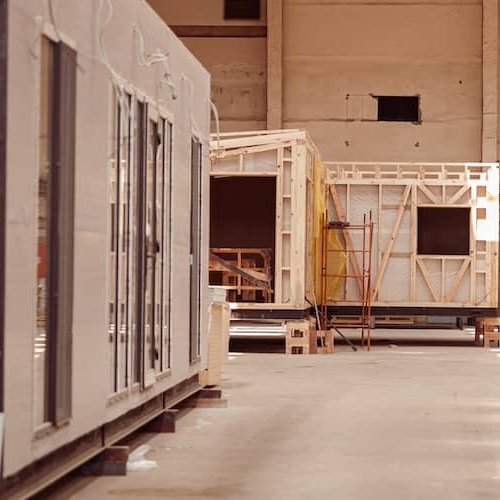What are panelized homes and how are they built?
Contributed by Tom McLean
Nov 6, 2025
•4-minute read

When you want to build a new home, you have many options at your fingertips. If you’re looking to save money, a panelized home is an option to consider. A panelized home is a type of prefab home, which is built in panels in a factory and assembled on site. It’s often more affordable than a traditional home build, often called a stick-built home.
What’s a panelized home?
A panelized home – sometimes called a kit home – is built in a climate-controlled indoor factory, shipped to its destination, and assembled. Panelized homes are built in less time than stick-built homes, limiting the home’s exposure to the elements before it’s completed.
Panelized homes must follow state and federal building code requirements and be inspected like traditional homes. However, the factory environment offers more quality control when building a house from the ground up.
Panelized homes are rare but growing in popularity. As of 2023, only 3% of homes in the U.S. were modular or panelized.
The building process for panelized home kits
The building process for panel home kits comes in two main stages. First, the design is finalized, and the components or panels are built in a factory. Then, the panelized home kit is shipped to the build site and assembled.
- Preproduction: Decisions such as those involving layout and materials are made.
- Manufacturing: The panels are constructed in a climate-controlled environment.
- Delivery: The panels are delivered to the site where the home will be built.
- Construction: The panels are assembled on the construction site foundation.
- Finishing: The interiors within the home can be completed.
Cost of panelized homes
The costs of panelized home kits vary depending on the kit, whether you assemble it yourself, and your location. On average, a panelized home kit can cost between $30 and $65 per square foot to build, but you'll need to spend more for labor if you don’t assemble it yourself.
While some people choose to pay cash for their panelized homes, there are options if you can’t afford the entire cost up front. There are lenders that offer a panelized home mortgage, which is similar to manufactured home loans and construction loans. Talk to a local lender to see what panelized home loan programs might be available to you.
Panelized homes vs. modular homes vs. manufactured homes
These homes are alternatives to stick-built homes, sharing some similarities but also some unique qualities.
|
|
Panelized homes |
||
|
Where is it built? |
Components are built in a factory and assembled on-site |
Modules are built in a factory and assembled on-site |
The entire home is built in a factory |
|
Who regulates it? |
Local building authorities |
Local building authorities |
HUD building codes |
|
Is it on a foundation? |
Yes |
Yes |
Sometimes |
|
Average cost |
$30 – $65 per square foot, depending on factors such as geographic location. |
$50 – $100 per square foot, depending on factors such as geographic location. |
$30 – $60 per square foot, depending on factors such as geographic location. |
Benefits of panelized homes
Panelized homes can be popular among many types of people. This includes first-time home buyers, families priced out of the stick-built home market, and retirees looking to downsize. That’s due, in part, to the following benefits.
Flexible designs
Panelized homes offer the option of flexible home design and floor plans for panelized homes. For example, you can choose from various building materials, cosmetic opportunities, floor plan flexibility, and architectural variety. Just like with a stick-built home, blueprints are used during construction. This allows you to work with architects and designers to get the floor plan that you want.
Energy efficient
If you want to build an energy-efficient home, panelized homes allow you to do so. Panelized homes can be built to align with green building certifications, including the ICC 700 National Green Building Standard. That means there is less waste, and clean-up is more manageable.
Furthermore, panelized homes also contribute to energy efficiency and lower heating and cooling costs because the house components are safer and drier when built indoors. The controlled-build environment keeps materials out of the elements, which can reduce waste. It also can help protect against warping, mold, mildew, and other issues that plague stick-built homes.
Cost and convenience
Panelized kits are usually cheaper than regular builds. Since all the modules are built in the same factory, they help control construction costs, with fewer delays and added expenses. And even if you choose to pay someone to assemble it on-site, fewer subcontractors can streamline the process, as you’re often working with the same company to design, engineer, and build the home.
Drawbacks of panelized homes
While there are plenty of benefits of panelized homes, they also come with some drawbacks that you’ll want to be aware of.
Transportation fees
One additional fee with this type of home is the cost to move it from the factory to the build site. Transportation companies may charge you a lot of money to transport the pieces of your home to the construction site. Additionally, you still must buy the land for your home, pay for utility connections, and cover other expenses. The costs for transportation, land, and utility hookups can vary widely depending on the size of your plot, where you live, and how far the site is from the home’s factory.
Assembly issues
In rare cases, there might be problems assembling the parts at the construction site. You may experience issues with panel damage during either delivery or assembly. Additionally, joint problems or leaks could be revealed once the parts are at the construction site, potentially causing delays.
The bottom line: Panelized homes may be a good option for you
Choosing the right building system is one of the most important aspects of home construction. Panelized homes take less time to build and limit parts of the home’s exposure to the elements than stick-built homes. Consider the pros and cons of panelized and other prefab homes, such as modular and manufactured homes. That can help you make the right choice for your specific situation.
If you’re ready to build a manufactured home or consider a construction loan, you can start online with Rocket Mortgage®.

Dan Miller
Dan Miller is a freelance writer and founder of PointsWithACrew.com, a site that helps families to travel for free/cheap. His home base is in Cincinnati, but he tries to travel the world as much as possible with his wife and 6 kids.
Related resources
6-minute read
Modular vs. manufactured homes: What's the difference?
Modular and manufactured homes are both factory-built, but they have some key differences. Uncover the distinctions between modular and manufactured homes.
Read more
10-minute read
How to buy a mobile or manufactured home
Manufactured homes can be an affordable option for home buyers as traditional home prices rise. Learn about getting a mobile home loan from Rocket Mortgage.
Read more
10-minute read
The basics behind financing a mobile or manufactured home
Manufactured or mobile homes may be the key to affordable homeownership. Learn how you can finance one under the favorable terms of conventional loans.
Read more